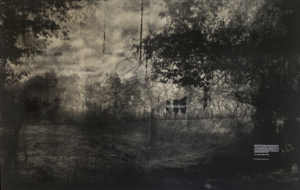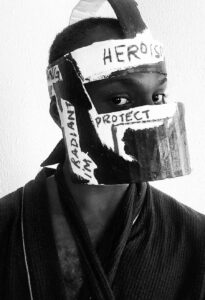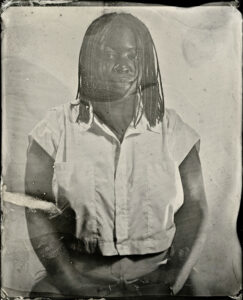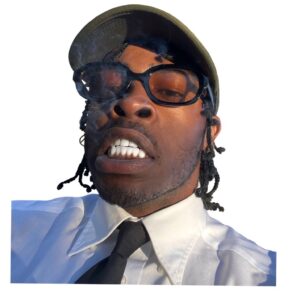A three-person exhibition featuring new and recent works from Chicago-based artists Ajmal ‘Mas Man’ Millar, Lola Ayisha Ogbara, and R. Treshawn Williamson exploring homeplace through sculpture, self-imaging, & materialism.

R. Treshawn Williamson. Charcoal rubbing, screen printed debris, White Oak, Etched plaque.
Left half. 15 x 20. 2021.
…of the land: acts of refusal and ratification features new and recent works from Chicago-based artists Ajmal ‘Mas Man’ Millar, Lola Ayisha Ogbara, and R. Treshawn Williamson exploring sculpture, self-imaging and history through postcolonial lenses, collective & individual recollection and peculiar materialism. Their use of storytelling holds significance for spatiality and locality to become common ground through the fielding of land, labor and industry.
Ajmal ‘Mas Man’ Millar expands the sculptural form welding metal, Trinidadian carnival culture and identity politics alongside the African diaspora. Lola Ayisha Ogbara merges West African and African American interior design aesthetics with bodily sculptural ceramic forms, with performative photography – that rest and refuse a Western gaze.
R. Treshawn Williamson creates historical context for his own familial roots in the mining of charcoal material for large scale screen-printed tapestries in a careful consideration of laborious processes as praxis. Millar, Ogbara and Williamson engage in practices that consider topographic timelines and performance as an essential tool making for an interesting dialogue about homeplace.
An opening reception will take place July 15th, 5- 8pm.
Please RSVP here

Ajmal ‘MAS MAN’ Millar is a self-taught contemporary visual artist and mas man (carnival costume designer). His work includes mixed–media sculpture that combine collage, painting, repurposed materials, scrap metal, performance, and photography interrogating notions of cultural heritage, sexual and gender identity, and ritual practices as a first-generation African American black queer man born to Trinidadian immigrants. Ajmal earned an undergraduate degree from Morehouse College in 2008 and earned an MFA from The School of the Art Institute of Chicago in 2021.
I am working on a collection of works engaging the Yoruba cosmological concept of Chi and its existence in everything, alive or inorganic. I create amalgamations of found objects and scraps of steel combined with encaustic. Inspired from my carnival technique of ‘wire bending’, Afrofuturism, and Afro Surrealism, I have an opportunity to express my emotions and thoughts as experienced in the various environments I collect from and exist in. My welding is drawing in space to depict the transcendent properties in masquerade. My goal is to contextualize a queer blackness rarely experienced through imagination, invention, and the investigation of dreams, magic, and ritual.
He currently lives and works in Chicago, IL.

LOLA AYISHA OGBARA (cultural worker & artist) born and raised in Chicago, Illinois holds many talents under her belt, i.e. sculpture, sound, design, photography and installation art. Ogbara holds a Bachelor of Arts in Arts Entertainment & Media Management from Columbia College Chicago in 2013 and a MFA in Visual Arts from Washington University Sam Fox School of Art & Design.
“My practice explores the multifaceted implications and ramifications of being in regards to the Black experience. I work with clay as a material in order to emphasize a necessary fragility which symbolizes an essential contradiction implicit in empowerments.”
In 2017, Ogbara co-founded Artists in the Room, a collective of artists and scholars who host artists, emerging and established, in hopes of serving as a catalyst for artist development and networking. Ogbara has also received numerous fellowships and awards, including the Multicultural Fellowship sponsored by the NCECA 52nd Annual Conference, the Arts + Public Life and Center for the Study of Race, Politics & Culture Residency at the University of Chicago, and the Coney Family Fund Award hosted by the Chicago Artists Coalition.
Ogbara has exhibited in art spaces across the country and is currently based in Chicago, IL.

R. Treshawn Williamson is a Chicago based essayist and multidisciplinary artist of Black American descent, from Prince George’s County, MD, by way of Livingston, Alabama, and Augusta, Georgia.
Williamson’s work is a meditation on the obstruction and surveillance of the lived histories of African-Americans. He investigates the application of cultural re-imagination in the African Diaspora through the engagement of oral histories, post-colonial theory, folklore, and ethnomusicology. In 2020 Williamson earned his BFA from the School of the Art Institute of Chicago.
He currently lives and works in Chicago, IL.



